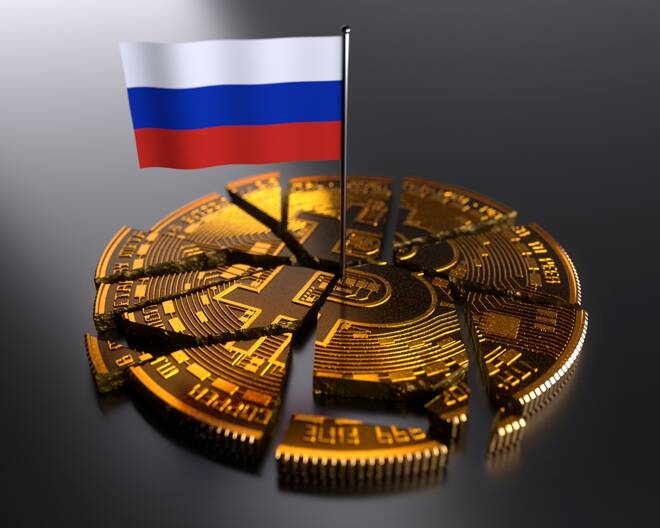Advertisement
Advertisement
IMF Targets Cryptos in Latest Global Financial Stability Report
By:
The IMF put crypto assets back in focus this week. After a push for a global regulatory framework, the IMF turned to focus on sanction evasion this week.
Key Insights:
- On Tuesday, the IMF highlighted the use of crypto assets in emerging markets to bypass capital restrictions and sanctions.
- The IMF’s Global Financial Stability Report called for a coordinated approach to crypto-assets.
- In January, the IMF pressed for a global regulatory framework to mitigate risks associated with financial interconnectedness.
It’s been a love-hate relationship for the crypto market in 2022. While politicians across some crypto jurisdictions have embraced crypto and the broader digital asset class, others have been less than impressed.
Agencies from several jurisdictions have also raised red flags over cryptos and the broader virtual space.
One vocal agency has been the International Monetary Fund (IMF), once headed by ECB President Christine Lagarde.
On Tuesday, the IMF released its quarterly Global Financial Stability Report. This quarter, the IMF paid more attention to crypto assets.
IMF Pushes for Crypto Global Standards in Response to Ukraine War
The IMF discussed the “widespread use of crypto assets in emerging markets to bypass capital restrictions and sanctions”
The IMF then discussed the “risks of cryptoization and sanction evasion through the crypto ecosystem.”
Here, the IMF noted a sharp increase in crypto asset trading volumes in some emerging market currencies.
According to the report,
“A more structural shift toward crypto assets as a means of payment and/or store of value could pose significant challenges to policymakers.”
The IMF highlighted a pronounced increase in stablecoin trading volumes in Turkey and in Russia following the introduction of sanctions and the use of capital restrictions in Russia and Ukraine.
In terms of sanctions evasion, the IMF noted that,
“The crypto ecosystem could allow users to circumvent such requirements through several means, including (1) the use of exchanges and other crypto asset providers that are non-compliant with sanctions and/or capital flow management measures; (2) poor implementation of adequate due diligence procedures by crypto asset providers; and (3) the use of technologies and platforms that increase the anonymity of transactions.”
The IMF then turned to crypto mining, another hot topic of the year, stating,
“Mining for energy-intensive blockchains like Bitcoin (BTC) can allow countries to monetize energy resources, some of which cannot be exported due to sanctions.”
Once more, the IMF called for
“A coordinated regulatory approach to crypto-assets,” adding,
“Implementation of the existing Financial Action Task Force standards is key to mitigating financial integrity risks that might give rise to illicit capital flows.
Laws and regulations for foreign exchange and capital flow management measures should be reviewed and amended if necessary to cover crypto assets even if they are not classified as financial assets or foreign currency.”
IMF Echoes Its January Call for a Global Regulatory Framework
In January, the IMF released a blog titled, Crypto Prices Move More in Sync with Stocks, Posing New Risks.
The blog discussed the maturing of crypto assets, such as Bitcoin, into an integral part of the digital asset revolution, raising financial stability concerns.
IMF concerns stemmed from a growing interconnectedness between cryptos and equity markets that would allow market shocks, which could destabilize financial markets.
The IMF’s concerns aligned with the Bank of England.
The Bank of England put cryptos back under the regulator spotlight in December. Due to the increased attention, the crypto market slid from November 2021 highs.
On November 10, Bitcoin hit an ATH of $68,979 before tumbling to a January and current year low of $32,991.
Bitcoin (BTC) Price Action
At the time of writing, BTC was down by 0.27% to $41,391.
BTC rose by 1.70% on Tuesday, following on from a 2.83% gain on Monday, with the crypto market brushing aside the IMF’s report.
Technical Indicators
Bitcoin will need to avoid the day’s $41,284 pivot to make a run on the First Major Resistance Level at $41,976. Bitcoin would need broader market support to break out from $41,500 levels.
In the event of another extended rally, Bitcoin could test the Second Major Resistance Level at $42,451 and resistance at $43,000. The Third Major Resistance Level sits at $43,619.
A fall through the pivot would bring the First Major Support Level at $40,809 back into play. Barring an extended sell-off, Bitcoin should avoid sub-$40,000. The Second Major Support Level at $40,117 should limit the downside.
Looking at the EMAs and the 4-hourly candlestick chart (below), it is a bullish signal. Bitcoin continues to sit above the 50-day EMA, currently at $40,885. This morning, the 50-day EMA narrowed to the 100-day EMA, providing support. The 100-day EMA held steady against the 100-day EMA.
A move through the 100-day EMA would support a return to $43,000 levels.
About the Author
Bob Masonauthor
With over 28 years of experience in the financial industry, Bob has worked with various global rating agencies and multinational banks. Currently he is covering currencies, commodities, alternative asset classes and global equities, focusing mostly on European and Asian markets.
Advertisement
